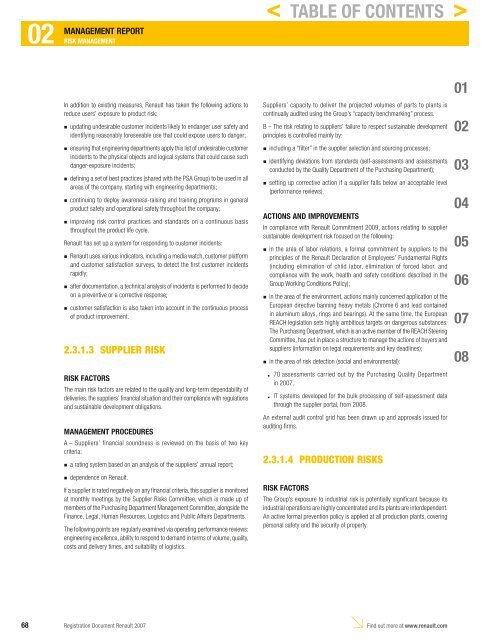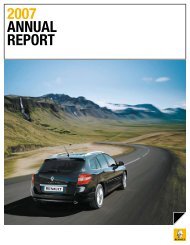2007 Interactive Registration Document - Renault
2007 Interactive Registration Document - Renault
2007 Interactive Registration Document - Renault
Create successful ePaper yourself
Turn your PDF publications into a flip-book with our unique Google optimized e-Paper software.
02 RISK<br />
MANAGEMENT REPORT<br />
MANAGEMENT<br />
In addition to existing measures, <strong>Renault</strong> has taken the following actions to<br />
reduce users’ exposure to product risk:<br />
n<br />
n<br />
n<br />
n<br />
n<br />
updating undesirable customer incidents likely to endanger user safety and<br />
identifying reasonably foreseeable use that could expose users to danger;<br />
ensuring that engineering departments apply this list of undesirable customer<br />
incidents to the physical objects and logical systems that could cause such<br />
danger-exposure incidents;<br />
defi ning a set of best practices (shared with the PSA Group) to be used in all<br />
areas of the company, starting with engineering departments;<br />
continuing to deploy awareness-raising and training programs in general<br />
product safety and operational safety throughout the company;<br />
improving risk control practices and standards on a continuous basis<br />
throughout the product life cycle.<br />
<strong>Renault</strong> has set up a system for responding to customer incidents:<br />
n<br />
n<br />
n<br />
<strong>Renault</strong> uses various indicators, including a media watch, customer platform<br />
and customer satisfaction surveys, to detect the fi rst customer incidents<br />
rapidly;<br />
after documentation, a technical analysis of incidents is performed to decide<br />
on a preventive or a corrective response;<br />
customer satisfaction is also taken into account in the continuous process<br />
of product improvement.<br />
2.3.1.3 SUPPLIER RISK<br />
RISK FACTORS<br />
The main risk factors are related to the quality and long-term dependability of<br />
deliveries, the suppliers’ fi nancial situation and their compliance with regulations<br />
and sustainable development obligations.<br />
MANAGEMENT PROCEDURES<br />
A – Suppliers’ financial soundness is reviewed on the basis of two key<br />
criteria:<br />
n<br />
n<br />
a rating system based on an analysis of the suppliers’ annual report;<br />
dependence on <strong>Renault</strong>.<br />
If a supplier is rated negatively on any fi nancial criteria, this supplier is monitored<br />
at monthly meetings by the Supplier Risks Committee, which is made up of<br />
members of the Purchasing Department Management Committee, alongside the<br />
Finance, Legal, Human Resources, Logistics and Public Affairs Departments.<br />
The following points are regularly examined via operating performance reviews:<br />
engineering excellence, ability to respond to demand in terms of volume, quality,<br />
costs and delivery times, and suitability of logistics.<br />
Suppliers’ capacity to deliver the projected volumes of parts to plants is<br />
continually audited using the Group’s “capacity benchmarking” process.<br />
B – The risk relating to suppliers’ failure to respect sustainable development<br />
principles is controlled mainly by:<br />
including a “fi lter” in the supplier selection and sourcing processes;<br />
identifying deviations from standards (self-assessments and assessments<br />
conducted by the Quality Department of the Purchasing Department);<br />
setting up corrective action if a supplier falls below an acceptable level<br />
(performance reviews).<br />
ACTIONS AND IMPROVEMENTS<br />
In compliance with <strong>Renault</strong> Commitment 2009, actions relating to supplier<br />
sustainable development risk focused on the following:<br />
in the area of labor relations, a formal commitment by suppliers to the<br />
principles of the <strong>Renault</strong> Declaration of Employees’ Fundamental Rights<br />
(including elimination of child labor, elimination of forced labor, and<br />
compliance with the work, health and safety conditions described in the<br />
Group Working Conditions Policy);<br />
in the area of the environment, actions mainly concerned application of the<br />
European directive banning heavy metals (Chrome 6 and lead contained<br />
in aluminum alloys, rings and bearings). At the same time, the European<br />
REACH legislation sets highly ambitious targets on dangerous substances.<br />
The Purchasing Department, which is an active member of the REACH Steering<br />
Committee, has put in place a structure to manage the actions of buyers and<br />
suppliers (information on legal requirements and key deadlines);<br />
in the area of risk detection (social and environmental):<br />
70 assessments carried out by the Purchasing Quality Department<br />
in <strong>2007</strong>,<br />
IT systems developed for the bulk processing of self-assessment data<br />
through the supplier portal, from 2008.<br />
An external audit control grid has been drawn up and approvals issued for<br />
auditing fi rms.<br />
2.3.1.4 PRODUCTION RISKS<br />
RISK FACTORS<br />
The Group’s exposure to industrial risk is potentially signifi cant because its<br />
industrial operations are highly concentrated and its plants are interdependent.<br />
An active formal prevention policy is applied at all production plants, covering<br />
personal safety and the security of property.<br />
68 <strong>Registration</strong> <strong>Document</strong> <strong>Renault</strong> <strong>2007</strong><br />
Find out more at www.renault.com<br />
n<br />
n<br />
n<br />
n<br />
n<br />
n<br />
< TABLE OF CONTENTS ><br />
.<br />
.<br />
01<br />
02<br />
03<br />
04<br />
05<br />
06<br />
07<br />
08




